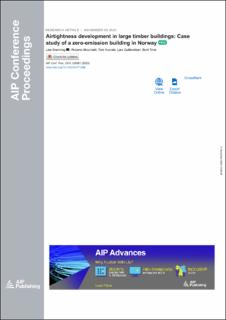| dc.description.abstract | Large timber buildings are increasingly used in the Nordic countries because of low greenhouse gas emissions and good access to timber. There is however uncertainty about the airtightness of the envelope of such buildings over time because of the possible timber’s shrinking and swelling, in particular when using cross laminated timber (CLT) in external walls. Therefore, two measures are often suggested to avoid moisture transport from inside to outside due to gaps in the joints of CLT external walls, i.e., a vapour barrier on the outside of the CLT elements and/or a local sealing of the joints. However, the airtightness development over time with only local sealings is uncertain. This paper presents the airtightness and thermographic assessment of a new zero-emission office building, built in 2020 in Norway. This building has a timber load-bearing system, including external timber frame walls and CLT-based walls. The timber frame walls have a vapour barrier on the warm side of the construction, while the CLT-based walls only present local sealing measures. Two thermal imaging and airtightness tests were performed: the first upon construction completion and the second after one year, to investigate possible changes in the airtightness of the building envelope over time. The air leakage results during the two tests performed with one year difference showed comparable building’s air change rate values of 0.46-0.47 h−1 at a pressure difference of 50 Pa. However, the thermographic examination of the envelope from inside the building showed that local sealings had cracked in several places because of the elements’ movement. This will be further investigated as it may affect the hygro-thermal and acoustic performance of the building. | en_US |
